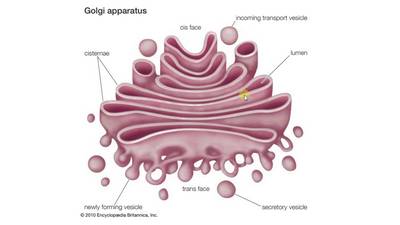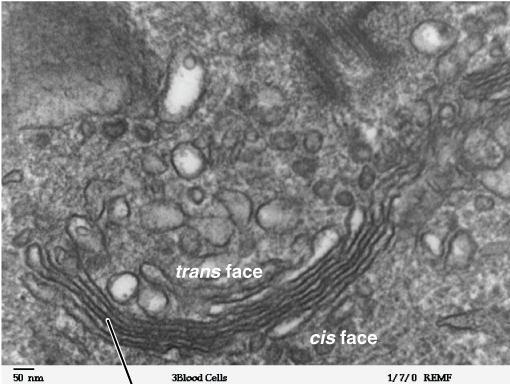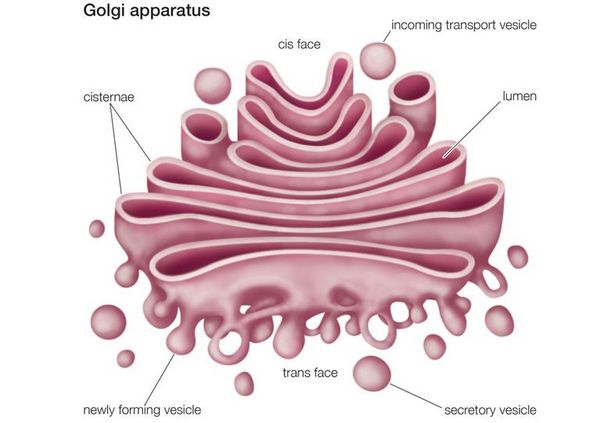Golgi Apparatus (Golgi Complex)

Content:
Definition
The Golgi apparatus, aka the Golgi complex, is one of the most important components in the structure of the cell. This cellular organelle was named after the Italian biologist Camillo Golgi, who discovered it back in 1898. The Golgi apparatus has the appearance of a complex of cavities bounded by single membranes. In fact, the Golgi apparatus is the membrane structure of a eukaryotic cell.
Structure
If we look at the Golgi apparatus through an electron microscope, we will see something resembling a stack of pouches stacked on top of each other with many bubbles nearby. There is a narrow channel in the middle of each pouch, which expands at the ends into the so-called tanks (bubbles appeared from them). A system of interconnected tubules is forming around the central stack.
The external side of the Golgi apparatus has a slightly convex shape, where our stacks form new tanks by the merger of bubbles appearing from a smooth endoplasmic reticulum. The tanks complete their ripening and also disintegrate again into bubbles from the inside of the apparatus. Similarly, there is a movement of tanks from the outside of the organelle to the inside.
Besides this, the part of the Golgi complex, which is located closer to the nucleus of the cell, is called “cis”, and the part that is closer to the membrane is called “trans”.

What does the Golgi apparatus look like? See this picture.
Functions
The role of the Golgi apparatus in the life of the cell is diverse. The Golgi apparatus is responsible for modification and redistribution of synthesizing substances and also their removal outside the cell, the formation of lysosomes and the construction of the cytoplasmic membrane.
The activity of the Golgi apparatus in secretory cells is very high. Proteins (that come from the endoplasmic reticulum) are concentrated in the Golgi apparatus, and then proteins are transferred to the membrane in the Golgi vesicles.
Functions in Plant Cell
The Golgi apparatus secrete carbohydrates, which serve as a matrix for plant cells during the formation of the cell wall. The budded Golgi vesicles move and their membranes merge with the cytoplasmic membrane, and the contents are incorporated into the cell wall.
Functions in Animal Cell
The Golgi complex of goblet cells (they are located in the thickness of the epithelium of the intestinal mucosa and respiratory tract) secrete mucin glycoprotein; it forms mucus.

The Golgi apparatus performs the important function of moving lipids in the intestinal cells. This happens this way: fatty acids and glycerol enter the cells, and then their lipids are synthesized in the endoplasmic reticulum. Most of the endoplasmic reticulum are coated with proteins and transported to the cell membrane using Golgi vesicles, through which the lipids will end up in the lymph.
Besides this, lysosomes are formed thanks to the Golgi apparatus.
References and Further Reading
- Pavelk M, Mironov AA (2008). “Golgi apparatus inheritance”. The Golgi Apparatus: State of the art 110 years after Camillo Golgi’s discovery. Berlin: Springer. p. 580. doi:10.1007/978-3-211-76310-0_34. ISBN 978-3-211-76310-0.
- Jump up to: a b c d Fabene PF, Bentivoglio M (October 1998). “1898-1998: Camillo Golgi and “the Golgi”: one hundred years of terminological clones”. Brain Research Bulletin. 47 (3): 195–8. doi:10.1016/S0361-9230(98)00079-3. PMID 9865849.
- Golgi C (1898). “Intorno alla struttura delle cellule nervose” (PDF). Bollettino della Societa Medico-Chirurgica di Pavia. 13 (1): 316. Archived (PDF) from the original on 2018-04-07.
- Jump up to: a b Davidson MW (2004-12-13). “The Golgi Apparatus”. Molecular Expressions. Florida State University. Archived from the original on 2006-11-07. Retrieved 2010-09-20.
- Jump up to: a b c d e f g h Alberts, Bruce; et al. (1994). Molecular Biology of the Cell. Garland Publishing. ISBN 978-0-8153-1619-0. Archived from the original on 2009-09-11.

Author: Pavlo Chaika, Editor-in-Chief of the journal Poznavayka
When writing this article, I tried to make it as interesting and useful as possible. I would be grateful for any feedback and constructive criticism in the form of comments to the article. You can also write your wish/question/suggestion to my mail pavelchaika1983@gmail.com or to Facebook.

